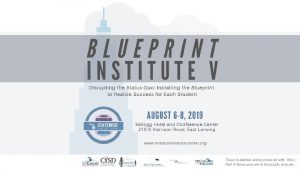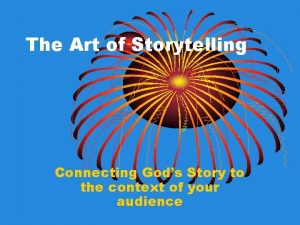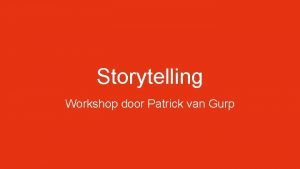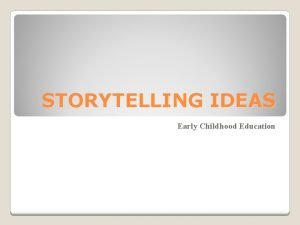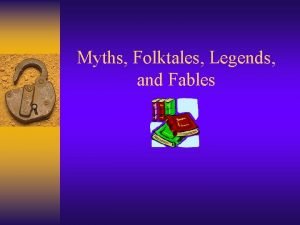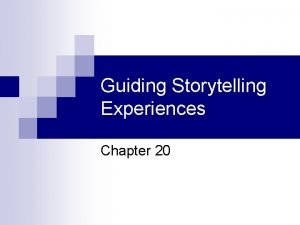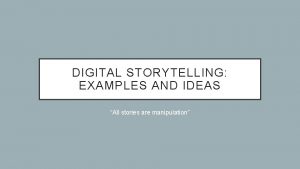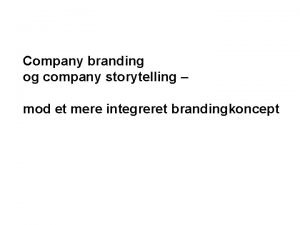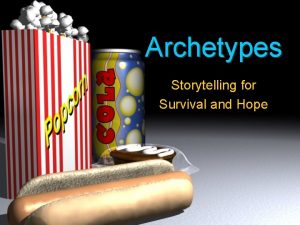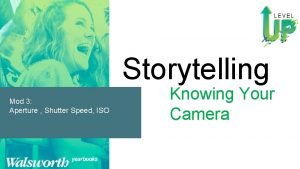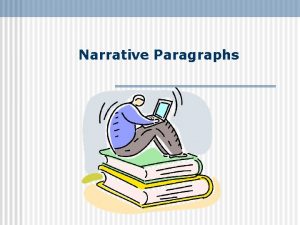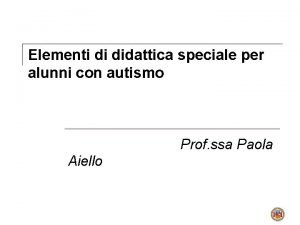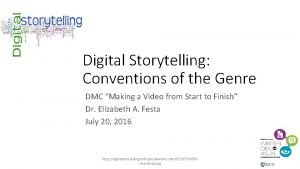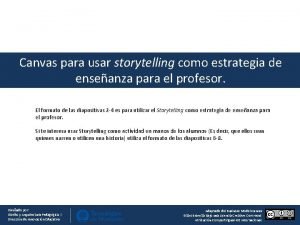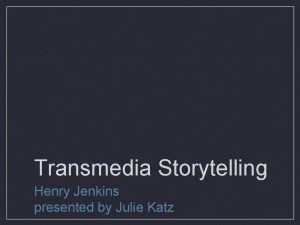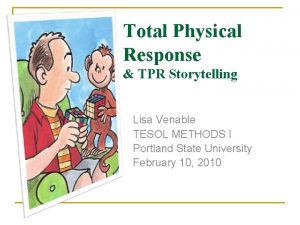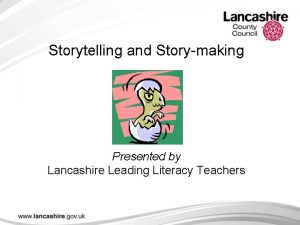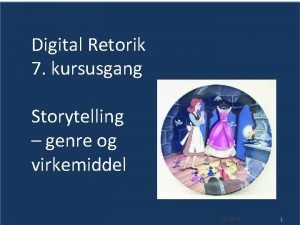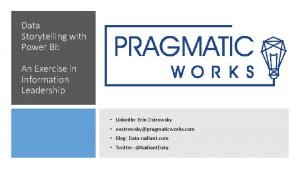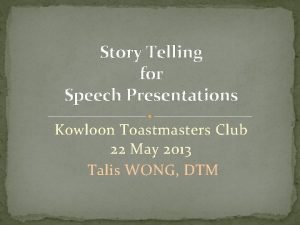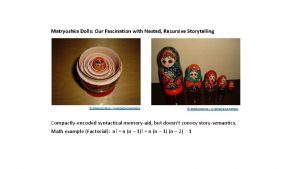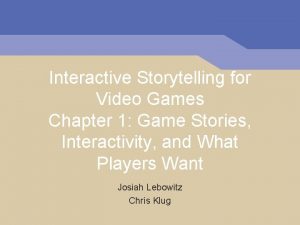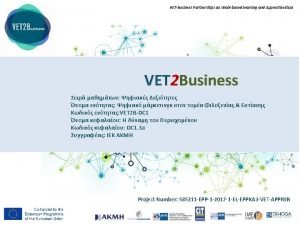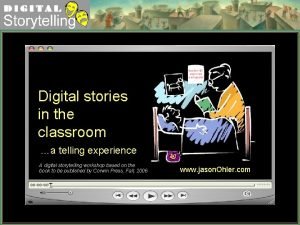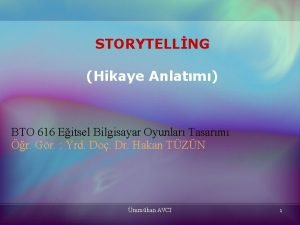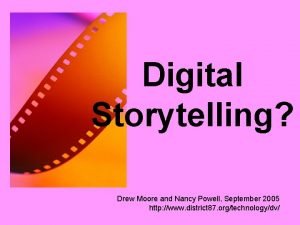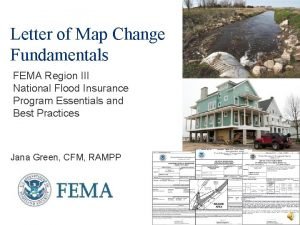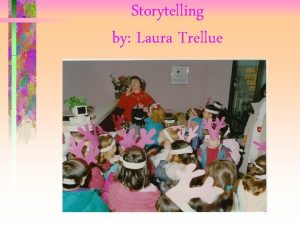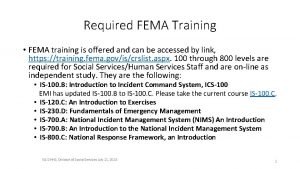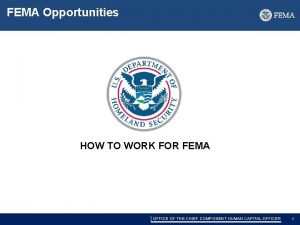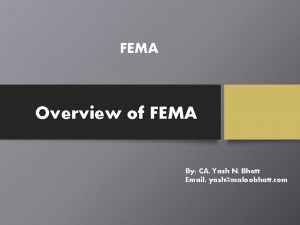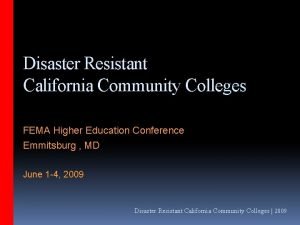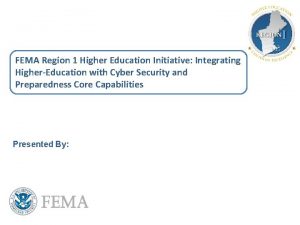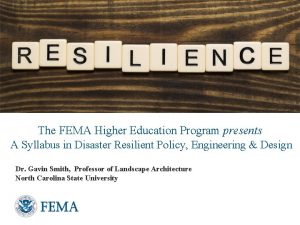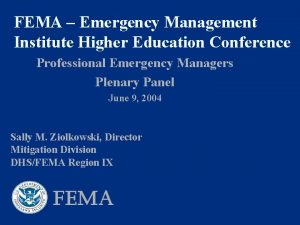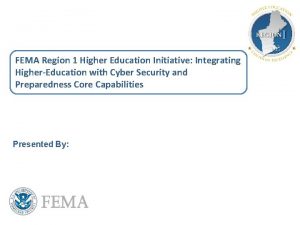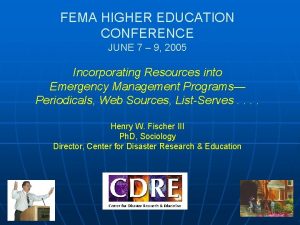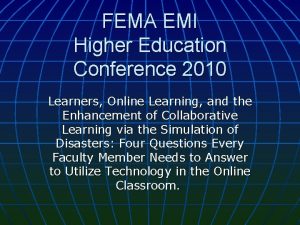Storytelling in EM Education FEMA NTES Higher Education










































- Slides: 42

Storytelling in EM Education FEMA NTES Higher Education Program Webinar October 16, 2018

FEMA Higher Education Program Wendy Walsh FEMA Emergency Management Higher Education Program Manager wendy. walsh@fema. dhs. gov FEMA- National Training & Education Division National Training & Education System National Emergency Training Center http: //training. fema. gov/hiedu Freitag, Hicks, Jerolleman October 16, 2018 2

Administrative § Submitting questions § File/Resource Sharing § The session will be recorded § Webinar is closed captioned § Access to Adobe site post webinar § How to follow up with presenters § How to get more information about the Higher Education Program Freitag, Hicks, Jerolleman October 16, 2018 3

Robert (Bob) Freitag Washington State University Freitag, Hicks, Jerolleman October 16, 2018 4

Storytelling Freitag, Hicks, Jerolleman October 16, 2018

Traditional Risk Analyses Freitag, Hicks, Jerolleman October 16, 2018

Determining Risk Through Storytelling In this exercise, we will focus on presenting risks as values and their provisional assets through storytelling. Let’s begin. Stories have three parts. They have a: 1. context, 2. problem (usually a change from normal), and 3. resolution. Freitag, Hicks, Jerolleman October 16, 2018

Sleepless in Seattle Context Values Assets Change/ Event (She wants more) (dissatisfied love interest, radio, friends…) Once upon a time… Resolution Assets Values Reassessed Resolution (love interest, (She found more) phone, friends…) And, then… All worked out… Freitag, Hicks, Jerolleman October 16, 2018

Storytelling Exercise Context Values Provisional Assets Change/ Event Resolution Assets Reassessed Values Reassessed Resolution • Values - Why are you attending this webinar, what values do you see in participating – write some verbs. • Provisional Assets - What things enable your participation? BEGIN WRITTING Once upon a time… Freitag, Hicks, Jerolleman October 16, 2018

Storytelling Exercise Context Values Provisional Assets Change/ Event What could prevent your participation? What would could prevent you attendance from Resolution being actualized? Local earthquake Assets • Reassessed Values Reassessed Resolution • Baby in the next room having a medical emergency • Loss of power Scenarios can reflect: • What you want to happen (aspirational) • Worse case • Most probable. BEGIN WRITING And, then… Freitag, Hicks, Jerolleman October 16, 2018

Storytelling Exercise • What assets (built, social, natural) are still available, Context Change/ left standing that may be redesigned to actualize you Event Values Provisional values? Assets • What assets are paramount? • Will you have to refine your value? BEGIN WRITING Resolution Assets Reassessed Values Reassessed Resolution All worked out… Freitag, Hicks, Jerolleman October 16, 2018

Will some one volunteer to tell their story. 1. Once upon a time… 2. And, then… 3. All worked out… Freitag, Hicks, Jerolleman October 16, 2018

Everett HMP Freitag, Hicks, Jerolleman October 16, 2018

Recording Sheet and Community Map https: //everettwa. gov/Document. Center/View/13998/Everett. HMP_2018 Freitag, Hicks, Jerolleman October 16, 2018

Thaddeus (Thad) Hicks, Ph. D Ohio Christian University Freitag, Hicks, Jerolleman October 16, 2018 15

Why A Story? Freitag, Hicks, Jerolleman October 16, 2018

Story A narrative, or report of a situation true or fictitious, in prose or verse, designed to interest, challenge, amuse, instruct, and hook the hearer or reader. Freitag, Hicks, Jerolleman October 16, 2018 17

Quick History of Information 100 Year Blocks of Time TV Radio Print Stories Freitag, Hicks, Jerolleman October 16, 2018 18

Since the first cave paintings were placed on the walls, telling stories has been one of our most fundamental communication methods, and there is science to back up why. Freitag, Hicks, Jerolleman October 16, 2018 19

Our brains become more active when we tell stories If we listen to any Power. Point presentation (except this one) with boring bullet points, certain parts in the brain get activated. Scientists call these Broca’s area and Wernicke’s area. Overall, it hits our language processing parts in the brain, where we decode words into meaning. And that’s it, nothing else happens. Freitag, Hicks, Jerolleman October 16, 2018 20

Our brains become more active when we tell stories When we are being told a story though, things change dramatically, according to researchers, not only are the language processing parts in our brain activated, but any other area in our brain that we would use when experiencing the events of the story are too. If someone tells us about how delicious certain foods were, our sensory cortex lights up. If it’s about movement, our motor cortex gets active Y Lerner, CJ Honey, LJ Silbert, U Hasson. “Topographic mapping of a hierarchy of temporal receptive windows using a narrated story” The Journal of Neuroscience, 2011 Freitag, Hicks, Jerolleman October 16, 2018 21

A story can put your whole brain to work. When we tell stories to others that have helped us shape our thinking and way of life, it can have the same effect on them. The brains of the person telling a story and listening to it, can in a sense synchronize. During the research, when the speaker spoke, and the listeners understood her story, their brains synchronized. When she had activity in her insula, an emotional brain region, the listeners did too. When her frontal cortex lit up, so did theirs. By simply telling a story, the woman could plant ideas, thoughts and emotions into the listener’s brains. Anything you’ve experienced, you can get others to “experience” the same. Freitag, Hicks, Jerolleman October 16, 2018 22

Our Brains are Looking for a Story Why does the format of a story, where events unfold one after the other have such a profound impact on our learning? A story, if broken down into the simplest form is a connection of cause and effect. We think in narratives all day long, no matter if it is about buying groceries, whether we think about work or our spouse at home. We make up (short) stories in our heads for every action and conversation. Freitag, Hicks, Jerolleman October 16, 2018 23

Now, whenever we hear a story, we want to relate it to one of our existing experiences. That’s why metaphors work so well with us. While we are busy searching for a similar experience in our brains, we activate a part called insula, which helps us relate to that same experience of pain, joy, disgust etc. We link up metaphors and literal happenings automatically. Everything in our brain is looking for the cause and effect relationship of something we’ve previously experienced. Freitag, Hicks, Jerolleman October 16, 2018

Our Goal as storytellers then needs to be to tell a story in a way that allows it to connect and stick with the listener. Freitag, Hicks, Jerolleman October 16, 2018

Crafting a Story Freitag, Hicks, Jerolleman October 16, 2018

A good storyteller takes people on a journey, leaving them feeling inspired and motivated. This is possible regardless of your topic. Structuring your “story” to get your ideas across and keep your audience engaged all the way through the entire process is tricky though. Time-tested techniques are required to get your message to stick. Freitag, Hicks, Jerolleman October 16, 2018

Kurt Vonnegut and his largely forgotten master’s thesis he wrote while studying anthropology at the University of Chicago. The thesis argued that a main character has ups and downs that can be graphed to reveal the taxonomy of a story. Vonnegut was convinced that these 8 types constitute every story. 1. Man in a hole 2. Boy meets Girl 3. From Bad to Worse 4. Which Way is Up 5. Creation Story 6. Old Testament 7. New Testament 8. Cinderella Freitag, Hicks, Jerolleman October 16, 2018

Maya Eilam, www. mayaeilam. com Freitag, Hicks, Jerolleman October 16, 2018

Telling Your Story? Freitag, Hicks, Jerolleman October 16, 2018

Freytag’s Pyramid 1. Exposition: setting the scene. The teller introduces the characters and setting, providing description and background. 2. Inciting Incident: something happens to begin the action. A single event usually signals the beginning of the main conflict. The inciting incident is sometimes called 'the complication'. 3. Rising Action: the story builds and gets more exciting. Gustav Freytag was a Nineteenth Century German novelist who saw common patterns in the plots of stories and novels and developed a diagram to analyze them. He diagrammed a story's plot using a pyramid like the one shown here: 4. Climax: the moment of greatest tension in a story. This is often the most exciting event. It is the event that the rising action builds up to and that the falling action follows. 5. Falling Action: events happen as a result of the climax and we know that the story will soon end. 6. Resolution: the character solves the main problem/conflict or someone solves it for him or her. 7. Dénouement: (a French term, pronounced: day-noomoh) the ending. At this point, any remaining secrets, questions or mysteries which remain after the resolution are solved by the characters or explained by the author. Sometimes the author leaves us to think about the THEME Freitag, Hicks, Jerolleman October 16, 2018 or future possibilities for the characters.

I cannot tell you one single way to tell your story. There are dozens of views surrounding this, but I will say that for it to truly hook a listener, it must be yours. Freitag, Hicks, Jerolleman October 16, 2018

Alessandra Jerolleman, Ph. D Jacksonville State University Freitag, Hicks, Jerolleman October 16, 2018 33

Narrative and Storytelling in EM Several applications: § Transmit Knowledge Within Organizations § Explicit and Tacit § Case Studies § Scenarios § Planning § Communication Freitag, Hicks, Jerolleman October 16, 2018 34

Why Narratives and Stories? Stories serve many purposes (Easton, 2016) § Meaning-Making § Providing Context § Transmitting Information and Emotion § Creating a Professional Identity § Promoting Empathy and Compassion § Memorializing We naturally use storytelling and narratives Freitag, Hicks, Jerolleman October 16, 2018 35

Narrative Pedagogy Developed in nursing education by Diekelmann § “gathers teachers and students into converging conversations” § Utilizes communal thinking and the sharing of experiences § Interpretation is a joint activity § Based upon a reciprocal relationship between teachers and students § Goes beyond using a storytelling to facilitating meaningmaking Freitag, Hicks, Jerolleman October 16, 2018 36

Narrative Pedagogy Additional Applications § Emergency Medicine § Accident Storytelling in Safety Teaching § Uncertainty and subjectivity (Rae, 2016) § Asset-Based Models Freitag, Hicks, Jerolleman October 16, 2018 37

Narrative Pedagogy and EM Narrative Pedagogy is not being explicitly utilized, but: § Storytelling is! § Learner participation, including storytelling, is also often utilized. § Andragogy tells us that the prior experience of the learner is important to adult learning Freitag, Hicks, Jerolleman October 16, 2018 38

Narrative Pedagogy and EM Research questions: § How is storytelling currently being utilized in the classroom? § Is narrative pedagogy applicable? § Are elements of a narrative pedagogy approach already being utilized informally? Would you like to participate? Share your experiences using narratives and storytelling? Freitag, Hicks, Jerolleman October 16, 2018 39

Discussion What Stories are we telling and hearing? National Preparedness System Freitag, Hicks, Jerolleman October 16, 2018 40

Contact Information Presenters: • Bob Freitag, bcfreitag@outlook. com • Alessandra Jerolleman, agazzo@gmail. com • Thaddeus Hicks, thicks@ohiochristian. edu EMI Higher Education Program Information: § Wendy Walsh, wendy. walsh@fema. dhs. gov 301 -447 -1262 § Barbara Johnson, Barbara. Johnson 3@fema. dhs. gov 301 -447 -1452 § Danielle Green, Danielle. green@associates. fema. dhs. gov 301. 447 -7251 https: //training. fema. gov/hiedu/educonference 19. aspx 21 st Annual Emergency Management Higher Education Symposium Freitag, Hicks, Jerolleman October 16, 2018 41

 Fema higher education
Fema higher education Cfd notes
Cfd notes Maysam mousaviraad
Maysam mousaviraad Pixar storytelling framework
Pixar storytelling framework Total physical response storytelling
Total physical response storytelling God of storytelling
God of storytelling Storytelling randsatd
Storytelling randsatd Ldoe finger
Ldoe finger Nonlinear plot
Nonlinear plot Explain
Explain Guiding storytelling experiences
Guiding storytelling experiences Digital storytelling examples
Digital storytelling examples Digital storytelling meaning
Digital storytelling meaning Corporate image måling
Corporate image måling Rebirth archetype examples
Rebirth archetype examples Storytelling mod
Storytelling mod Define narrative paragraph
Define narrative paragraph Storie sociali a fumetti
Storie sociali a fumetti Storytelling conventions
Storytelling conventions Storytelling canvas example
Storytelling canvas example Uil oral reading poems
Uil oral reading poems Henry jenkins transmedia
Henry jenkins transmedia Total physical response storytelling
Total physical response storytelling The little green dinosaur story map
The little green dinosaur story map Unit one the power of storytelling
Unit one the power of storytelling Eventyrmodellen
Eventyrmodellen Data storytelling with power bi
Data storytelling with power bi Storytelling for sales professionals
Storytelling for sales professionals Toastmasters storytelling speech
Toastmasters storytelling speech Shadow storytelling
Shadow storytelling Nested loops storytelling
Nested loops storytelling Intraplay
Intraplay Interactive storytelling for video games
Interactive storytelling for video games Storytelling content marketing
Storytelling content marketing Role of storytelling
Role of storytelling Storytelling esempi scritti
Storytelling esempi scritti Digital storytelling rubric
Digital storytelling rubric Storytelling nedir
Storytelling nedir 7 elements of storytelling
7 elements of storytelling Product management storytelling
Product management storytelling Adobe spark storytelling
Adobe spark storytelling Fema gras certification
Fema gras certification Fema region 3 map
Fema region 3 map



